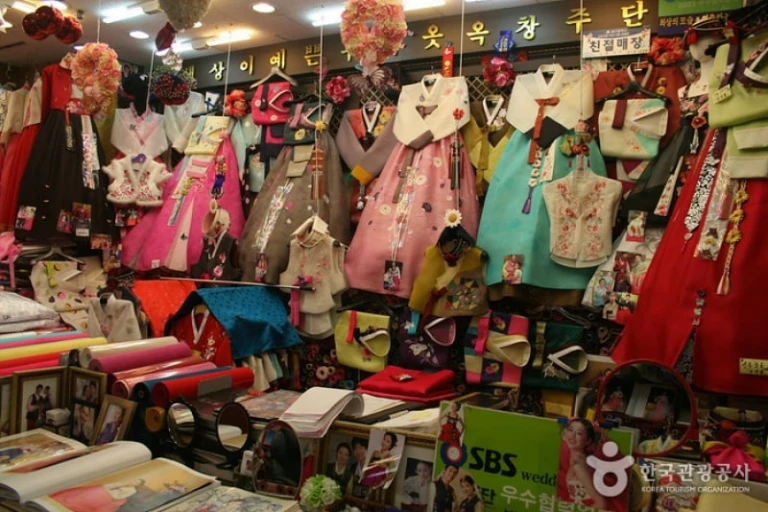8 Lesser-Known Traditional Markets to Visit in Korea
South Korea is undoubtedly a favourite destination for many travellers! However, instead of the usual shopping and eating, why not do something different for a change on your next trip?
Take your senses for a roller coaster ride at any of these 8 lesser-known traditional markets. Revel in the markets’ distinctive local atmosphere, heritage and warm energetic vibes before digging into a mouth-watering array of street foods. Get your stomachs ready, you’re in for a feast!
1. Sokcho Tourist and Fishery Market, Gangwon

Image credit: Korea Tourism Organization
Formerly known as the Jungang market, the Sokcho Tourist and Fishery Market was opened in 1982 and comprises more than 450 stalls selling fishery products, street food and clothes. The market is great for locals and tourists to enjoy the local Sokcho cuisine!

Image credit: Korea Tourism Organization
Think sweet, spicy and fried; the Dak Gangjeong is a must try at the Sokcho Market! Juicy chicken pieces are battered, fried to a rich golden brown and then coated with a sticky sweet and spicy sauce before being topped with crushed peanut garnish. It is not too difficult to locate this shop, just keep your eyes peeled for the abstract calligraphy logo!
Be sure to also try the Ojingeo Sundae, Sokcho’s speciality squid dish which is native to the Gangwan province. The squid is stuffed with rice and vegetables and is enjoyed steamed or pan-fried in an egg batter. Just the right balance of seafood and earthy goodness!

Image credit: Korea Tourism Organization
Looking for something sweet? Try the popular Hotteok, the deep-fried Korean version of mochi! Once cooked, the mochi is cut in half and stuffed with a generous amount of crushed peanuts and sugar which caramelises beautifully in the heat.
Address: 16, Jungang-ro 147beon-gil, Sokcho-si, Gangwon-do
How to get there: Take a bus from Dong Seoul Bus Terminal or Seoul Express Bus Terminal to Sokcho Express Bus Terminal, and then take a bus (1, 1-1, 7, 7-1, 9-1, 88) from the terminal’s entrance to the market.
2. Jeonju Nambu Market, Jeollabuk-do

Image credit: Korea Tourism Organization
A city with rich culture and history, Jeonju has a distinguishing charm that differentiates it from other cities like Seoul, Busan or Jeju. Open in 1905, the Jeonju Nambu market is the oldest traditional market in the gourmet city of Jeonju. You can find almost everything at the market, with over 800 stalls hawking goods ranging from food and fresh product to furniture and clothes.
In efforts to revitalise the market, the second floor of the indoor Nambu market was transformed into a Youth Market, giving the marketplace a young and trendy vibe. This area serves as a cluster for young designers, baristas and entrepreneurs who set up small cafes, bars, galleries and accessories shops.

Image credit: Korea Tourism Organization, New York
What’s more, the place transforms into a buzzing, lively night market on Fridays and Saturdays, drawing in huge boisterous crowds. Once the sun starts to set, hundreds of colourful bulbs light up the open air ceiling of the indoor market, and festive music is turned on to add to the ambience.
Do try the Nokdujeon (pan-fried mung bean pancake), a typical Korean street food made with crunchy green bean sprouts and seafood. If you’re feeling adventurous, do try the Soondae (blood sausage soup) which is a famous local delicacy.
Address: 63, Pungnammun 2-gil, Wansan-gu, Jeonju-si, Jeollabuk-do
How to get there: Take a bus from Dong Seoul Bus Terminal to Jeonju, and then take a bus from Jeonju Intercity Bus Terminal (684, 61) to Pungnammun Gate Bus Stop. Alternatively, take a train from Yongsan Station to Jeonju station, then take a bus (119) to Pungnammun Gate bus stop.
3. Songjeong Station 1913 Market, Gwangsan-gu

Image credit: Korea Tourism Organization
Head to Songjeong Station Market for a traditional market experience with a modern twist! Opened in 1913, the Songjeong Station Market was THE place for essential everyday items and groceries. However, with the influx of large hypermarkets, the number of patrons dwindled. Therefore, in efforts to draw the crowds back again, the entire Songjeong market was redesigned around the theme of time.

Image credit: 1913송정역시장
The newly revamped market, which reopened in April 2016, features a bright trendy appearance with modern architecture while keeping its old exteriors. Each shop even has its own personalised signboard describing its history and origins!
During the weekends, the hip, young crowd of Gwangju flock to the market, which is also a very Instagram-worthy location! The unique characteristic of this market would be its motto of “change to preserve” – where it has managed to keep its traditional value despite its modernisation.

Image credit: Korea Tourism Organization
The Gyeran Bap (rice with egg), Tteokgalbi (beef patty) and Eomuk (fish cake) are not to be missed when visiting the Songjeong Station Market! Be sure to get a freshly baked loaf filled with your choice of cheese, blueberry or chocolate from Ttoa Bread, a popular buy among the locals. Alternatively, try your hand at traditional gift wrapping by taking a class at one of the stalls called Bukakmaeul, which sells food snacks. Do note that the market is closed on the second and fourth Mondays of every month!
Address: 13, Songjeong-ro 8beon-gil, Gwangsan-gu, Gwangju
How to get there: Take a train from Yongsan Station to Gwangju-Songjeong Station.
4. Seogwipo Maeil Olle Market, Jeju

Image credit: Korea Tourism Organization
A beautiful city perched on the southern coast of Jeju Island, Seogwipo is South Korea’s version of Hawaii! It has a dreamy sense of an idyllic paradise – there’s sunshine, the ocean AND all the makings of an ideal destination.

Image credit: Korea Tourism Organization
Seogwipo is home to the enchanting Seogwipo Maeil Olle Market, which is full of vitality and activity. Started in the early 1960s, it is a major food source for the locals living in the town. When you visit the Olle market, be sure to bring along an empty stomach and a huge appetite! You will also realise that the real charm of the market is in the interaction with the locals, a.k.a. the thrill of getting a discount and the kindness of the merchants selling their goods.

Image credit: garycycles
Numerous types of goodies are sold at this market, such as Gimbap, Tteokbokki, Kimchi pancakes and the sweet Jeju mandarins. One should not miss trying the black pig skewers, which are cooked over open charcoal giving it a smoky flavour. Warning: be prepared to wait for some time in the snaking queue for those juicy, succulent pieces of pork!

Image credit: Doldam Guesthouse, Jeju
Be sure to also try the Omegi rice cake, a traditional sweet Jeju delicacy which has either a mixed nut or red bean versions. Another must-try snack is the Instagram-worthy octopus pan-fried bread, which oozes of chewy cheese with each bite!
Address: 22, Jungjeong-ro73beon-gil, Seogwipo-si, Jeju-do
How to get there: Take the airport limousine bus (600) from Jeju International Airport to Seogwipo, then take another bus from Seogwipo Intercity Bus Terminal to the market.
5. Seomun Market, Daegu

Image credit: Korea Tourism Organization
Seomun Market of Daegu is one that is steeped in history. Together with Ggangyeong and Pyeongyang Markets, Seomun Market was one of the three main markets during the Joseon Dynasty. Although the market has expanded, the names of several of its alleyways – such as Hongdukkaejeon and Dakjeon – remain unchanged.

Image credit: Korea Tourism Organization
The most sought-after specialities in Seomun are the Kalguksu (knife cut noodle soup) and the Nabjak Mandu (flat dumplings). Flavourful and hearty, the Kalguksu is a savoury noodle soup with an anchovy vegetable broth and is paired well with Kkakdugi (radish) kimchi and crunchy peppers. The Mandus are made with a thin and chewy dough casing and pop with a burst of flavour once you bite into them!

Image credit: Korea Tourism Organization
Always dreamt of being a Korean princess after watching the popular K-drama series, My Princess? Spoil yourself with a tailor-made Hanbok (Korean traditional costume)! Seomun Market also has various stalls specialising in fabric-related items like silk, satin, and linen goods and clothing.

Image credit: Korea Tourism Organization
The Seomun Market also features a night market which comes alive after 7pm! It features more than 65 stalls selling night street food and about 15 stalls selling various goods and clothing. Do bring along sufficient cash as you’re probably going to spend lots on the various treats such as pan-friend Udon, seafood skewers, waffles and Hanayaki (Korea’s savoury version of your favourite Mr Bean pancakes)! Do note that the market is closed on the first and third Sundays of the month.
Address: 45, Keunjang-ro 26-gil, Jung-gu, Daegu
How to get there: Take the Daegu Subway Line 2 to Seomunsijang Station, exit at Exit 1 and walk there from the Dongsan Intersection.
6. Bupyeong Kkangtong Market, Busan

Image credit: Korea Tourism Organization
Do you know how Busan’s Bupyeong Market got its nickname of “Kkangtong (tin can) Market”? During the Korean war, this market had a wide variety of imported canned goods from the United States for the US forces stationed in Korea. Many rare foreign goods that were hard to find at that time could only be found here!

Image credit: Korea Tourism Organization
After 7pm, a lively night market opens at the public parking lots and at Arcade 2 of the market. More than two dozen mobile cooking stalls open along a 110-metre stretch, and you will be spoilt for choice when deciding what foods to try! If you’re there at the right time, you might be lucky enough to catch the magic show and guitar performance which take place twice a day at the intersection inside of the market.
Its reputation and potential as an “International” market still remain, with many stalls selling different types of food from all over the world. From Turkish Kebabs to Indonesian Mee Goreng, the night market could indeed even pass off as an international food fair!
Address: 48, Bupyeong 1-gil, Jung-gu, Busan
How to get there: Take the Busan Subway Line 1 to Jagalchi Station, and exit at Exit 7.
7. Gukje Market, Busan

Image credit: Korea Tourism Organization
Located near the above-mentioned Bupyeong Market is another traditional market that is definitely worth a visit. The Gukje Market is one of Korea’s largest markets, and is comparable to the renowned Namdaemun Market in Seoul! Refugees who fled to Busan following the Korean War set up various stalls to earn a livelihood, and that paved the way for the modern-day Gukje Market.

Image credit: Korea Tourism Organization
Containing about 690 stalls, the market sells a wide variety of products. Apart from food and clothes, you can also purchase kitchen appliances and electronics here. The must-try foods at this market include Yubu-Jeongol (fried tofu stew), Ssiat-Hotteok (sweet Korean pancake stuffed with seeds) and Bibim-dangmyeon (spicy glass noodles). Do note that the market is closed on the first and third Sundays of the month.
Address: Sinchang-dong 4-ga, Jung-gu, Busan
How to get there: Take the Busan Subway Line 1 to Jagalchi Station, and exit at Exit 7.
8. Danyang Gugyeong Market, Chungbuk

Image credit: Korea Tourism Organization
One word to describe Danyang? Garlic! This town in North Chungcheong Province is a famous producer of garlic. Many dishes and traditional medicinal treatments in Danyang are centred around the strong-smelling, pungent-tasting bulbous plant (which goes oh-so-well with savoury food!).

Image credit: Korea Tourism Organization
While you are at the Gugyeong Market, keep your eyes peeled for the O-seong Roasted Chicken. Be sure to also try the garlic shrimp dumplings which are sure to allure you with their strong distinctive smell of garlicky, seafood-y goodness!
Address: 31, Dojeon 5-gil, Danyang-eup, Danyang-gun, Chungcheongbuk-do 27011, South Korea
How to get there: Take a bus from Dong Seoul Bus Station to Danyang Intercity Bus Station.
Indeed, the term “traditional markets” often brings to mind two conflicting images. To some, it stirs images of a rustic, working-class market full of warmth, life and heart. To others, it conveys a stereotype of being unkempt and unhygienic. However, the various city councils do recognise the value of traditional markets and are stepping up to renovate and revitalise the marketplaces. Young, local entrepreneurs are also actively participating in the scene, injecting youthful vibes into the market atmosphere while maintaining its traditional charm.
We hope that you are ever more excited to visit these cultural, thriving hubs of activity – they offer a truly local experience nary found in the usual shopping malls or Korean barbeque joints. For more information, visit Korea Tourism Organization’s official website and Facebook page. Happy exploring and feasting!
Published at
About Author
Subscribe our Newsletter
Get our weekly tips and travel news!
Related Posts
10 Beautiful Hill Stations in Odisha for Family Vacations
Odisha's hidden gem - hill stations!
10 Best Destinations for Solo Trips in India
Find tranquility in India with these 10 unique solo travel destinations that promise relaxation and personal reflection in nature and culture.
10 Best Indian Beaches to Visit Post Monsoon
As the rains recede and golden skies return, India's beaches come alive. Here are 10 of the best coastal getaways to explore after the monsoon in 2025.
10 Best Places in India to Celebrate Ganesh Chaturthi 2024
Explore the 10 best places in India to celebrate Ganesh Chaturthi!
10 Best Places to Visit in the Philippines With Friends for an Unforgettable Adventure
The Philippines offers the perfect backdrop for unforgettable adventures with friends.
Latest Posts
India Extends e-Tourist Visa Validity to 4 Months from December 2025
International travelers can now apply 120 days before arrival, making trip planning easier.
10 Countries Indians Travelled to Most in 2025: Gen Z Leads Travel Boom
Thailand tops the list as 90% of international trips come from millennials and Gen Z travelers.
5 Floating Markets in India You Can Visit by Boat
Explore India’s coolest floating markets! From Srinagar to Kerala, shop on boats for a major vibe. No cap, it’s a must-see!
7 Indian Cities with Hop-On Hop-Off Tourist Buses and Routes
Explore India at your own pace! Discover 7 cities with easy Hop-On Hop-Off buses, routes, and budget-friendly tips.
5 Motorcycle Rental Routes in Ladakh for Enfield Enthusiasts in 2026
From Nubra Valley to Pangong Lake, explore the best Ladakh motorcycle rental routes for Royal Enfield riders planning a 2026 trip.

